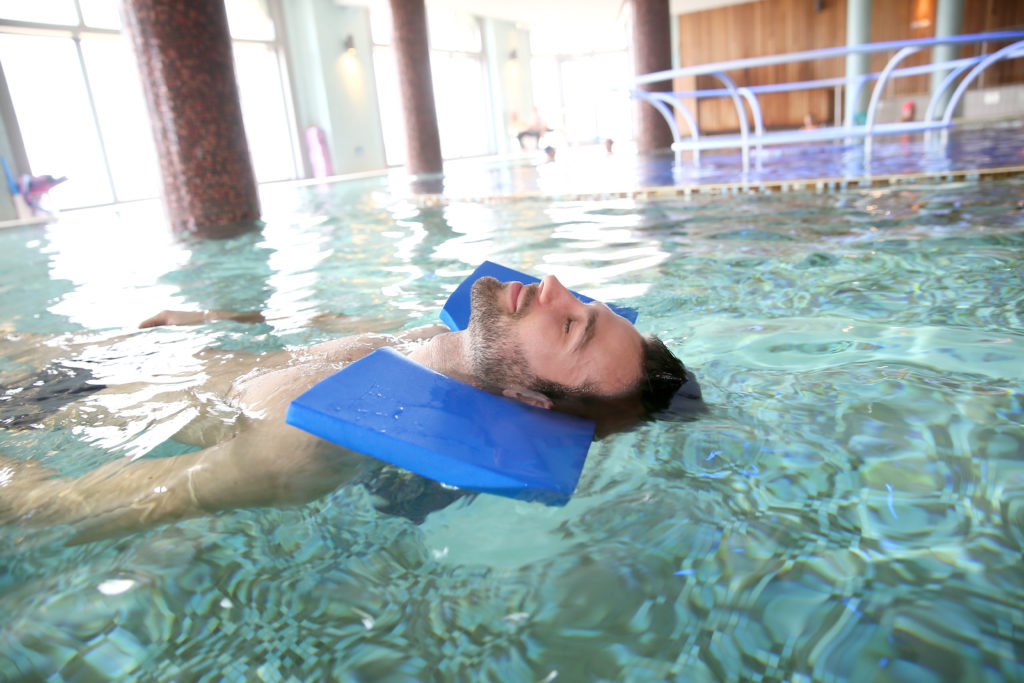By Kim Anderson, PhD

Have you ever heard of aquatic therapy? Have you ever wondered if it would be helpful with your spinal cord injury? A new research article (https://pubmed.ncbi.nlm.nih.gov/36966260/ ) was recently published discussing the benefits of aquatic therapy so we thought this would be a topic of interest for our readers.
Aquatic therapy is water-based therapeutic exercise. It is also sometimes called hydrotherapy. The value of doing exercises in water is based on 3 physical properties: temperature, density, and viscosity.
- Temperature – The temperature of the water is important, with the ideal temperature being around 88-91 degrees Fahrenheit. If the temperature is too cold, it can cause your body to lose heat. If the temperature is too hot, it can cause your blood pressure to drop too low. At the ideal temperature, however, water can allow your muscles to relax.
- Density – The density of water is what creates a ‘reduced gravity’ environment. Basically, this is why we can float in water.
- Viscosity – Viscosity refers to a fluid’s resistance to flow. Water has a relatively low viscosity whereas honey has a high viscosity. As the temperature lowers, the resistance to flow increases as well. Though water has a low viscosity it still offers some resistance to movement, which can be useful for therapy.
The new research article by Palladino and colleagues reviewed the published literature on aquatic therapy for people with spinal cord injury and concluded the benefits summarized below.
- Lung function – Respiratory problems or complications can be very problematic for people with SCI. Doing exercise while in water can help improve lung function. This is because when you are immersed in water up to your shoulders the resistance of the water increases pressure on your chest. This pressure makes it a little harder to breathe in (inhaling) yet promotes breathing out (exhaling), which makes you work a little harder to breathe in and out. That, in turn, helps strengthen your lungs. The stronger your lungs are, the less chance you have of developing respiratory problems.
- Cardiorespiratory endurance and exercise capacity – In addition to strengthening your lungs, aquatic therapy can increase your cardiorespiratory endurance, which can thereby increase your capacity to exercise. Cardiorespiratory endurance is a way of measuring how well your heart and lungs are delivering oxygen to your muscles when you are exercising. Improving your cardiorespiratory endurance can allow you to exercise for longer periods of time without getting tired, which then allows you to reap other benefits of exercise.
- Spasticity management – Spasticity can also be problematic for many people living with SCI. It is most commonly treated with passive range of motion (stretching) or medication (baclofen), but these do not always work, or the side effects may be bothersome. The warm water temperature combined with the ability to float allows the muscles to relax. In a research study comparing 10 weeks of aquatic therapy (3 sessions/ week for 20 minutes/session) compared to passive range of motion, the aquatic therapy led to a reduction is spasm severity as well as a reduction in oral baclofen intake. If the water temperature is too cold, however, it can make spasticity worse.
There is a great resource in the greater Cleveland area if you are interested in starting aquatic therapy. The Peter B. Lewis Aquatic & Therapy Center located in Menorah Park is open to our community.
https://www.menorahpark.org/services/peter-b-lewis-aquatic-therapy-center/overview

Their goal is “to help you feel better and maximize your potential”. They offer the following services:
- Personalize a plan for your physical therapy visits;
- Assess the cause of your pain or discomfort;
- Provide the most appropriate therapy to treat your problem; the one-stop shop for all your therapy needs, any discipline (PT, OT, ST) with many specialties;
- Engage in one-to-one therapy; 45-60 minutes of undivided attention to ensure consistent observation and optimal results;
- Monitor your progress and keep your physician informed;
- Specialize in aging well;
- Provide free transportation within their service area for your convenience;
- Work with you to create a Lifelong Health plan for you to follow when you have completed therapy;
- Nurture a supportive environment.
The Peter B. Lewis Aquatic & Therapy Center is at 27300 Cedar Rd, Cleveland, Ohio 44122 and you can contact them by phone, 216-595-7345, email, mgroesch@menorahpark.org , or Facebook, https://www.facebook.com/PeterBLewisAquaticandTherapyCenter/ .
Reference article: Palladino L, Ruotolo I, Berardi A, Carlizza A, Galeoto G. Efficacy of aquatic therapy in people with spinal cord injury: a systematic review and meta-analysis. Spinal Cord. 2023 Jun;61(6):317-322. doi: 10.1038/s41393-023-00892-4.
